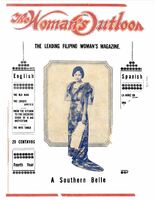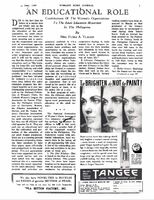The Philippines counted with many different types of magazines and journals; they vary on language, ideology, political stance and many other aspects. In the 20th century, a new genre of magazines were being published: women’s magazines. These were magazines designed and marketized solely for women. According to Carol L. Mitchell, early women’s magazines drew on the women’s organization journal. She traces their origins back to “women’s social and political organizations that formed during colonial rule” (Mitchell 1998, 250). For her part, Cynthia Ruth Rivera, who has researched on the role these magazines played during the American colonial rule, highlights the fact that these magazines reflected the national publication trends in the Philippines. The earliest magazine from the American colonial period, Filipinas, Revista Semanal Ilustrada, contained articles both in Spanish and Tagalog. However, as time went by, particularly in the 1920s, magazines such as The Woman’s Outlook and Woman’s Home Journal were published in Spanish and English. By the 1930s, magazines were being published solely in English. The first one to do this was The Woman’s World (Rivera 2004, 6).
The first thing that one notices about any magazine or newspaper is the front page. The covers of these magazines often featured “pretty mestizas wearing ternos or dalagitas (female adolescents) with baskets of fruits on their heads or being serenated by young men” (Encanto 2004, 20). For example, on the cover page of The Woman’s Outlook, we can see a Filipino woman wearing a typical dress with the caption “A Southern Belle''.
The Woman’s Outlook and Woman’s Home Journal–formerly known as Woman’s Journal– were the two outstanding women's magazines from that period (Encanto 2004, 18). The former was published on a monthly basis, having released its first issue in October 1929. It contributed as the official publication of the National Federation of Women’s Clubs of the Philippines. In accordance to Mitchell’s study on the contents of magazines from Southeast Asia, Georgina R. Encanto not only describes The Woman’s Outlook’s contents as “what would become the classic formula for successful women’s magazines in the Philippines'' (Encanto 2004, 20), but also provides a list of central topics which is similar to Mitchell’s. In her study on different women’s magazines from Southeast Asia, she distinguishes a certain pattern between all of them: “Throughout the region, magazine racks bulge with the latest issues of home and fashion magazines whose covers portray the modern Asian women and whose contents promise readers new insights into male-female relationships, divulge the latest gossip, and counsel readers on decorating, beauty, and fashion” (Mitchell 1998, 249). This list is in concordance to Rivera’s, the findings of which show that women’s magazines during the American colonial period encompassed the following topics: “housekeeping, the role of the wife, motherhood, politics, women’s organizations, the arts, travel, fashion, health, sanitation and hygiene, values formation, community service, suffrage, debates on whether the “bob cut” is the better hairstyle or why chaperones are necessary, etc.” (Rivera 2004, 16).
An issue of Woman’s Home Journal with many articles about education and literacy
For its part, Woman’s Home Journal also presented these topics within its pages. Its first issue came out in 1920 and was being published by the same board as The Woman’s Outlook, namely, the Philippine Journal of Education Commission (Encanto 2004, 18-20). In addition to the other topics mentioned above, education was an important subject for the magazine’s editors. The issue from 1936 contained a predominant amount of articles dedicated to education as a result or a response to Rafael Palma’s reforms to the educational system in the Philippines.
Women’s magazines played an important part in society, but also performed a substantial role in the making of the “modern” Filipina, whether it was through calling attention to what different women’s organizations were achieving and their future goals, or through the publication of articles advocating for change or addressing a particular issue. These aspects will be further developed in the section on “Suffragism” and “the Representation of Women in Newspapers”.
Bibliographic references
Encanto, Georgina R. 2004. “Women’s Magazines in English from 1920 to 1972: Instruments of American Hegemony.” Plaridel 1 (1): 15-30.
Mitchell, Carol L. 1998. “The New Asian Woman: Women’s Magazines and the Spread of Mass-Culture in Southeast Asia.” The Serials Librarian 35 (1-2): 247-259.
Rivera, Cynthia Luz. 2004. “Filipino Women’s Magazines 1909-1940: Resistance, Cultural Subversion, and Compromise.” Plaridel 1 (2) : 1-20.


